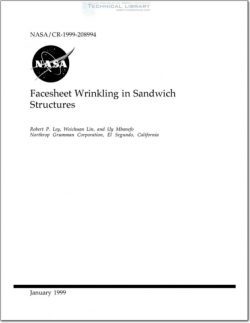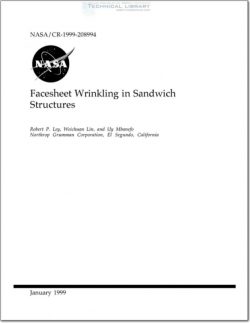NASA-CR-1999-208994

- Version
- 297 Downloads
- 1.93 MB File Size
- 1 File Count
- July 14, 2016 Create Date
- July 14, 2016 Last Updated
Facesheet Wrinkling in Sandwich Structures

The purpose of this paper is to provide a concise summary of the state—of—the—art for the
analysis of the facesheet wrinkling mode of failure in sandwich structures. This document is not
an exhaustive review of the published research related to facesheet wrinkling. Instead, a smaller
number of key papers are reviewed in order to provide designers and analysts with a working
understanding of the state—of—the—art. Designers and analysts should use this survey to guide their
judgment when deciding which one of a wide variety of available facesheet wrinkling design
The development of fiber composite materials and the drive to reduce both the weight and
the cost of aerospace structures has resulted in renewed interest in the use of sandwich
construction for primary structures. As considered in this paper, a sandwich structure consists of
two thin load—bearing facesheets bonded on either side of a moderately thick, lightweight core
that prevents the facesheets from buckling individually. The sandwich structure attains its
bending rigidity mainly by separating the facesheets. Solid cores such as those made from foam
or balsa wood, or cellular cores such as those made from aluminum honeycomb, may be used.
Sandwich structures exhibit very high structural efficiencies (ratio of strength or stiffness to
weight). Furthermore, use of sandwich construction in laminated fiber composite applications is
particularly attractive since laminated facesheets can be manufactured into complex curved
shapes more easily than equivalent metallic facesheets. In addition, with composite materials the
facesheet laminates and the facesheet—to—core bond can be cured in a single operation without the
need for complex tooling. With sandwich structures the use of discrete stiffening elements can
be minimized. Cocuring discrete stiffeners and skins is expensive due to the need for complex
tooling; furthermore, these stiffeners give rise to high localized stresses that can be particularly
damaging to laminated composite structures.
Sandwich structures with thin facesheets and lightweight cores are prone to a type of local
failure known as facesheet wrinkling or simply wrinkling. Since sandwich structures may exhibit
little or no post—wrinkling load carrying capability, failure of these structures by faoesheet
wrinkling is typically catastrophic. Hence, accurate prediction of facesheet wrinkling is
important to the development of reliable and efficient sandwich structures. Throughout this
report, the term wrinkling refers to modes having wavelengths up to the thickness of the core.
The term buckling is used in a more general sense, referring to instability modes, regardless of
the mode’s wavelength.
The purpose of this paper is to provide a concise summary of the state—of—the—art of the
analysis for the facesheet wrinkling mode of failure in sandwich structures. The objective here is
not to provide an exhaustive summary of all the research related to facesheet wrinkling published
in the literature. Instead, the purpose is to present more information from a smaller number of
key papers in order to provide designers with a working understanding of the state—of—the—art.
Designers and analysts should use this survey to guide their judgment when deciding which one
of a wide variety of available facesheet wrinkling design formulas is applicable to a specific
design problem.
| File | Action |
|---|---|
| NASA-CR-1999-208994 Facesheet Wrinkling in Sandwich Structures.pdf | Download |
Comment On This Post